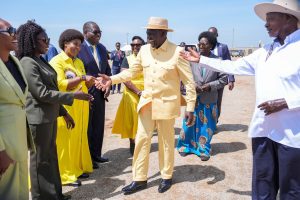President Museveni and Kenyan President William Ruto on Monday presided over the launch of a $500 million (Shs1.78 trillion) steel plant in Utro Village, Kayoro Sub-county in Tororo District, marking one of the region’s most significant industrial milestones.
The project, undertaken by the Devki Group of Companies, is set to become East Africa’s largest steel manufacturing facility once it is fully developed. The plant will rely on Uganda’s mineral wealth, sourcing 65% iron-content hematite from Kabale and 50% iron-content magnetite from the eastern region.
Once operational, the facility is expected to drastically reduce Uganda’s heavy dependence on imported steel products, including iron sheets, angle bars and other essential construction materials. 
Devki Group’s executive chairman, Narendra Raval, said the investment will play a major role in narrowing Uganda’s trade deficit.
“The plant will help reduce Uganda’s trade deficit by more than $1 billion,”he noted, explaining that Uganda currently spends nearly $500 million annually on steel imports.
Raval added that the project will create about 15,000 jobs, with an estimated 5,000 positions reserved for Tororo residents, and reaffirmed the company’s commitment to improving community welfare through strong corporate social responsibility programs.
Energy and Mineral Development Minister Ruth Nankabirwa described the steel venture as a monumental step in Uganda’s mineral value-addition drive.
She highlighted that government signed a Mineral Development Agreement on April 2, 2025, setting clear obligations for both the state and the investor to ensure the factory’s success.
Her sentiments were echoed by President Ruto, who praised the project’s scale and long-term significance.
He said the vertically integrated project is “a new chapter in Africa’s industrial ambitions and a demonstration of the region’s commitment to sustainable development.” 
Ruto added that the new plant reinforces East Africa’s ability to build competitive and reliable industries. He further announced that Kenya will construct a dual-carriage highway from Nairobi to Malaba, followed by the completion of the Standard Gauge Railway (SGR) from Naivasha to Malaba to ease regional trade and transport.
President Museveni, meanwhile, placed the project within a broader historical context, describing it as part of the “liberation process of East Africa” and a rejection of Africa’s long record of exporting raw minerals.
He reiterated his long-standing position against exporting unprocessed resources, stressing that value addition creates jobs for Ugandans.
Museveni also revealed that Uganda is preparing to start construction of its section of the Standard Gauge Railway to reduce transportation costs and ease pressure on aging road infrastructure.
But the President expressed displeasure at the land disputes that surrounded the project. Museveni condemned what he called fraudulent claims by some residents of Utro who he said falsely asserted ownership of government land and sought compensation from the investor.
He pledged that government would refund the money the investor paid out and cautioned communities against trying to profit from public land.
Museveni then directed the First Deputy Prime Minister and Minister for East African Affairs to resolve the issue and ensure fair, lawful management of the land.





















